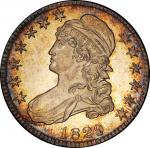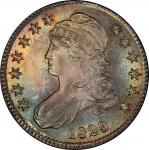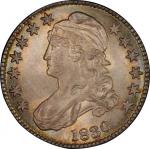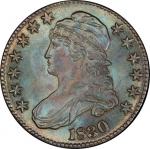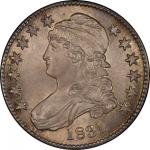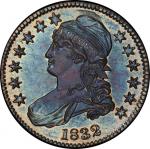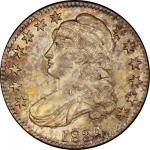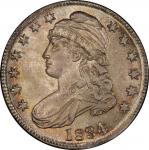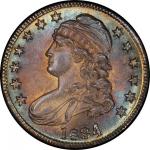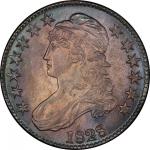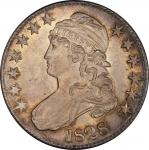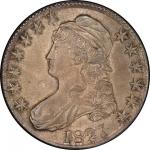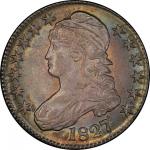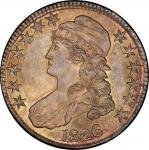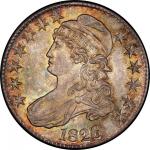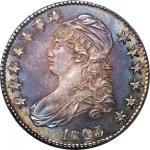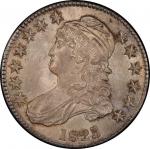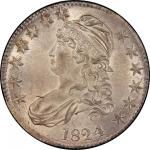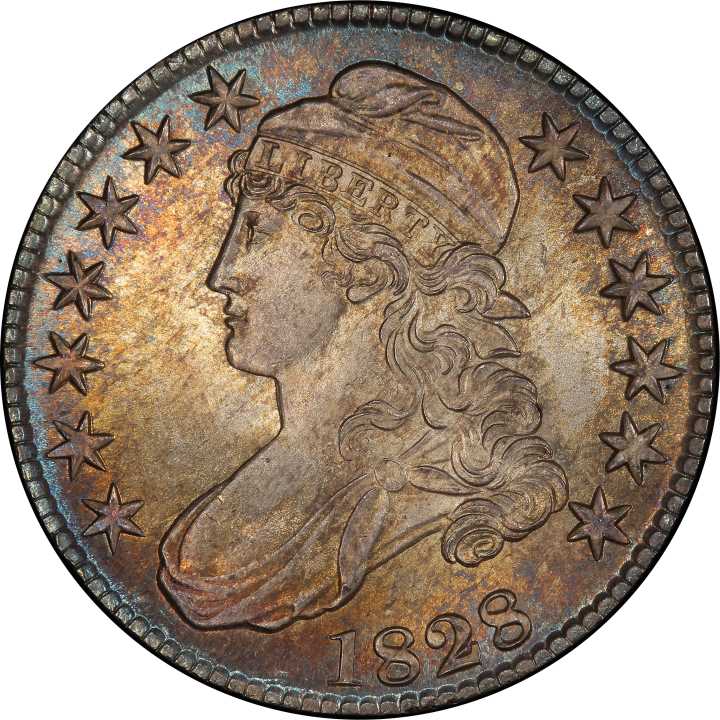“I saw also, in company with Messrs. Vaux and Niederstetter, the mint of the United States, which is established here. ... We saw, moreover, the cutting of half dollar pieces, which is done by means of a stamp, worked by two men.” — Bernhard, Duke of Saxe-Weimer-Eisenach, Travels Through North America During the Years 1825 and 1826, 1828 Cartwheel luster boldly spins around both sides, enlivening the frost on the obverse and the light reflectivity of the reverse. Exceptional toning adds superb visual appeal, with pastel blue occupying a thin circle close to both rims, surrounding a broad expanse of gold that deepens to amber and violet at the peripheries. The strike has produced excellent central detail on both sides and given the central devices their intended richness, though all stars but 4, 10, and 11 lack their centers. The fields are particularly free of distractions, showing no noticeable hairlines. Just minor contact points are seen on the portrait, including a few marks low on Liberty’s bust. As described by Overton, two muted lapping lines are visible left of the date, hugging the denticles below. One of the most numismatically important travelogues of the era was published in Philadelphia in 1828. Travels Through North America In The Years 1825 and 1826 was printed in both English and the native German of its author, Prince Bernhard of Saxe-Weimer-Eisenach. Prince Bernhard’s journal expounded on collections he saw in museums in Boston and Cincinnati, as well as a private collection in Bethlehem, Pennsylvania that was assembled by “a gentleman, who, with trouble and expense, had established a cabinet of ancient and other coins. This collection was indeed extensive and valuable, recollecting that it was in America.” Showing an interest in currency as well as coins, Bernhard lamented that a bank in Georgia had suspended specie payments and was thus closed, rendering it impossible “for me to obtain its notes, which, for the curiosity of the thing, I would gladly have taken back with me to Germany.” Prince Bernhard’s numismatic curiosity inspired a lengthy description of his May 1826 visit to the United States Mint. He was unimpressed by the structure, calling it “very small” and “limited by a twelve horse-power steam-engine” that had not yet been engineered to run coining presses. His description of the Mint workmen’s labor likewise seems a bit dismissive; aside from energetically rolling ingots into planchet stock, punching planchets from stock, and striking coins, they weren’t very busy. “They were doing but little when we came; we saw nothing but the stretching of the bars of silver between cylinders, like those in the rolling mills at Pittsburgh, and the stamping of the pieces, which was done by means of a contrivance similar to that by which rivet-holes are made in the iron plates for steam-engine boilers.” Bernhard and his two American tour guides saw half dollars being struck and gave a description of the planchet feeder system: “We saw, moreover, the cutting of half dollar pieces, which is done by means of a stamp, worked by two men. A third stands by to place the uncoined pieces in a box, which are then brought under the stamp by a particular contrivance. After they are coined, they fall by means of this contrivance into a box which stands below.” One can imagine by Prince Bernhard’s imprecise terminology that he had never delved too deeply into the mechanical arts. However, his description of planchet cutting, gravity-fed planchet feeding, and the staffing of screw presses makes his eyewitness account an important source for modern researchers. This impressive survivor comes from one of the great old-time holdings of beautifully toned coins. Herrman has listed this as the finest known example of the variety in his various editions of Auction and Mail Bid Prices Realized for Bust Half Dollars for over a decade. Among all the coins struck from the 14 different die varieties included within the Square Base 2, Small 8s, Large Letters designation, PCGS has never assigned a grade higher than MS-66. Only one other MS-66 (PCGS) of the Square Base 2, Small 8s, Large Letters variety has ever been offered at public auction, an O-118 sold in the June 2008 Bowers and Merena sale. PCGS# 39770. NGC ID: 24FR.


